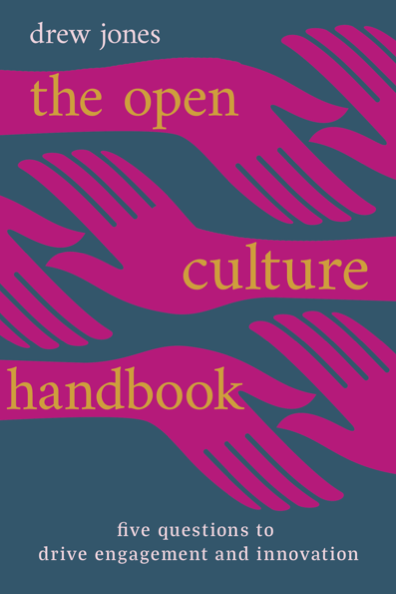Books
The Studio’s Thought Leadership

The Open Culture Handbook: Five Questions to Drive Engagement and Innovation
The Open Culture Handbook is a search for the natural company- places where humans can be…human. I explore companies that align strategy with humans’ cultural nature to innovate and perform.
The book provides a simple, five-question model for understanding company culture from the employees’ perspective. A design-thinking framework is provided as a guide for transforming culture.
The 15 case examples presented in the book demonstrate that employee-centered companies can be as or more financially competitive and successful than conventionally managed companies.
Drew’s Previous Books
The Fifth Age of Work
The Fifth Age of Work (2013) explores the evolution of work, workplace strategy, and design in the ages freelance work, activity-based working (ABW), coworking, and hybrid working. The book focuses on three levers of workplace/workforce transformation- space, talent, license. In the book I anticipate the emergence of hybrid working by about a decade, showing that what is happening today (post-pandemic) is a slow and evolutionary process of change.
Table of Contents
Introduction: The New Social Contract of Work
Chapter 1: The Artisan Economy & Coworking
Chapter 2: Corporate Workplace Innovations
Chapter 3: The End of Corporate Culture (as we know it)
Chapter 4: Design Thinking (and doing) To the Rescue
Chapter 5: The Great Talent Mashup
Chapter 6: The Power of Workspace Design
Chapter 7: The License to Innovate
Chapter 8: The Fifth Age Workbook
Conclusion: Leadership in the Fifth Age
The Innovation Acid Test
The Innovation Acid Test (2008) was an early exploration of the application of design thinking (DT) to the challenges of corporate innovation. It develops a model that integrates architecture, design, and anthropology into an innovation framework. Specific emphasis is placed on organic growth through innovation. Case studies include- Southwest Airlines, Whole Foods, Google, Starbucks, Innocent Drinks, Shanghai Tang.
Table of Contents
Introduction
Chapter 1: Architecture and the ‘Timeless Way of Building’
Chapter 2: Innovation by Design
Chapter 3: Anthropology & Innovation
Chapter 4: Employees First: Cultural Innovation at Southwest Airlines
Chapter 5: It’s All Teams at Whole Foods
Chapter 6: Stimulating Customer Experience at Starbucks
Chapter 7: Google and All the Information in the World
Chapter 8: One Hundred Percent Innocent
Chapter 9: ‘Designed in China’ by Shanghai Tang
Conclusion: Innovating in a Theory X World



